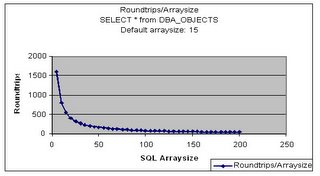I ran a series of select statements using the SQL*Plus interface to a development environment and varied the ARRAYSIZE starting at 5 and working up to 200 in increments of five. The following chart shows the results for the example select statement:
SELECT * FROM dba_objects;
I utilized the SET AUTOTRACE ON STATISTICS and SET TIMING ON commands to gather statistics on net round trips and time required to satisfy the select statement.

As you can see the benefits for this select statement fall off after an ARRAYSIZE of 50 is reached. A plot of the roundtrips verses ARRAYSIZE tells why. In the following chart of roundtrips verses ARRAYSIZE setting you see that at 50 the value for roundtrips is 147 having reduced from the high of 1606 by 90%, from array sizes 50 to 200 it only decreases to 42 a change of only 10% (based on the original 1606) fewer roundtrips.
Where this can be of real benefit is in a Java situation. To set the array size, use the setDefaultRowPrefetch method of the OracleConnection class. However, the size should be determined empirically by setting the size and running test runs because this is a case of diminishing returns as the array size gets larger. Also, the size of network buffers and packets need to be factored in when sizing the buffers in SQL.


No comments:
Post a Comment